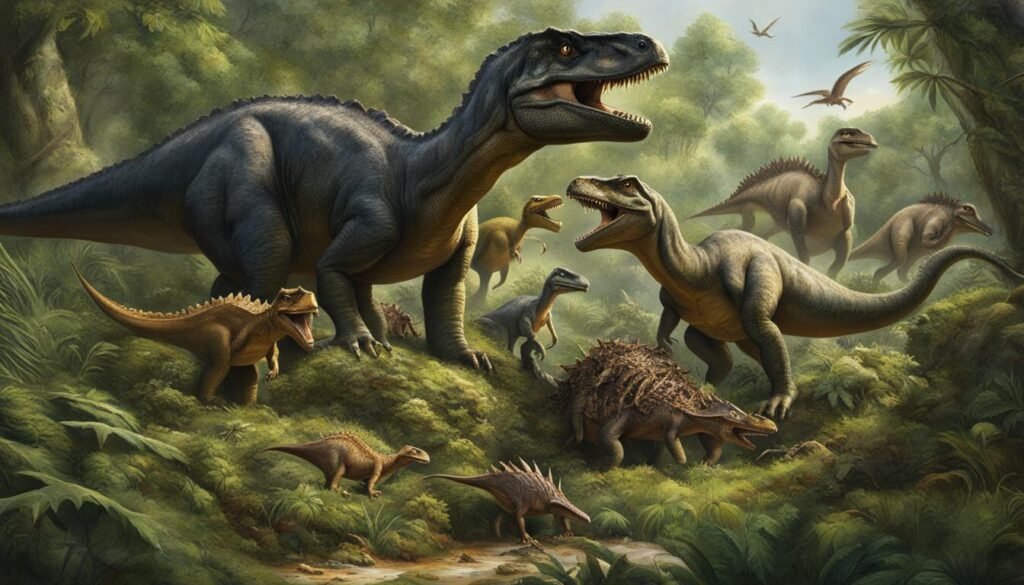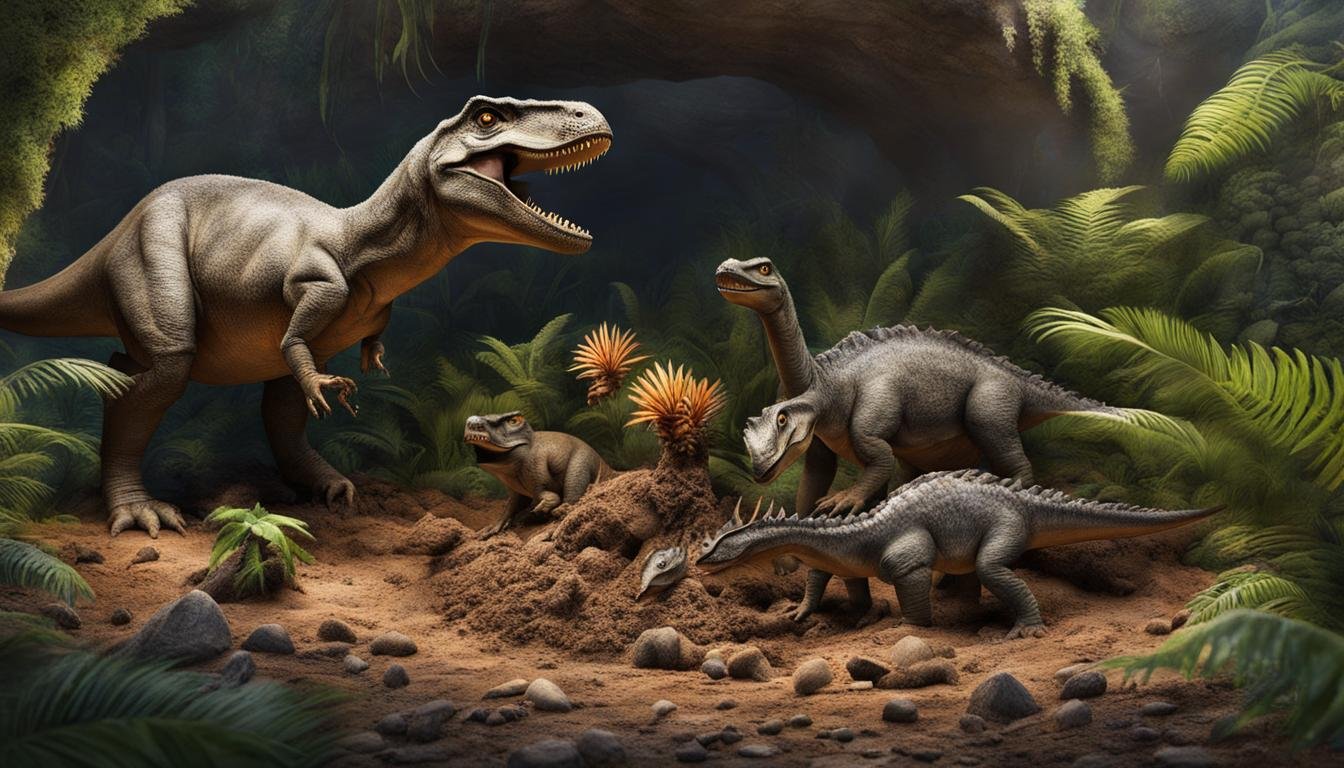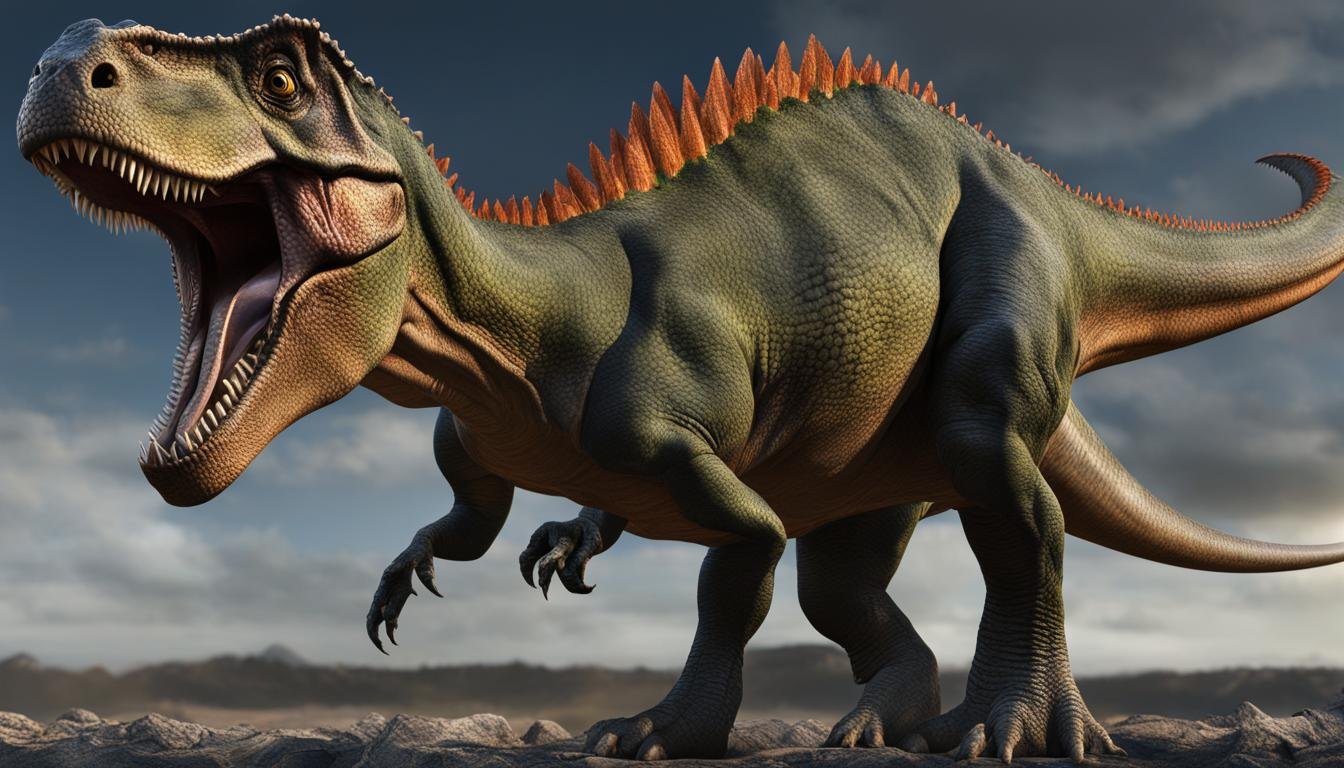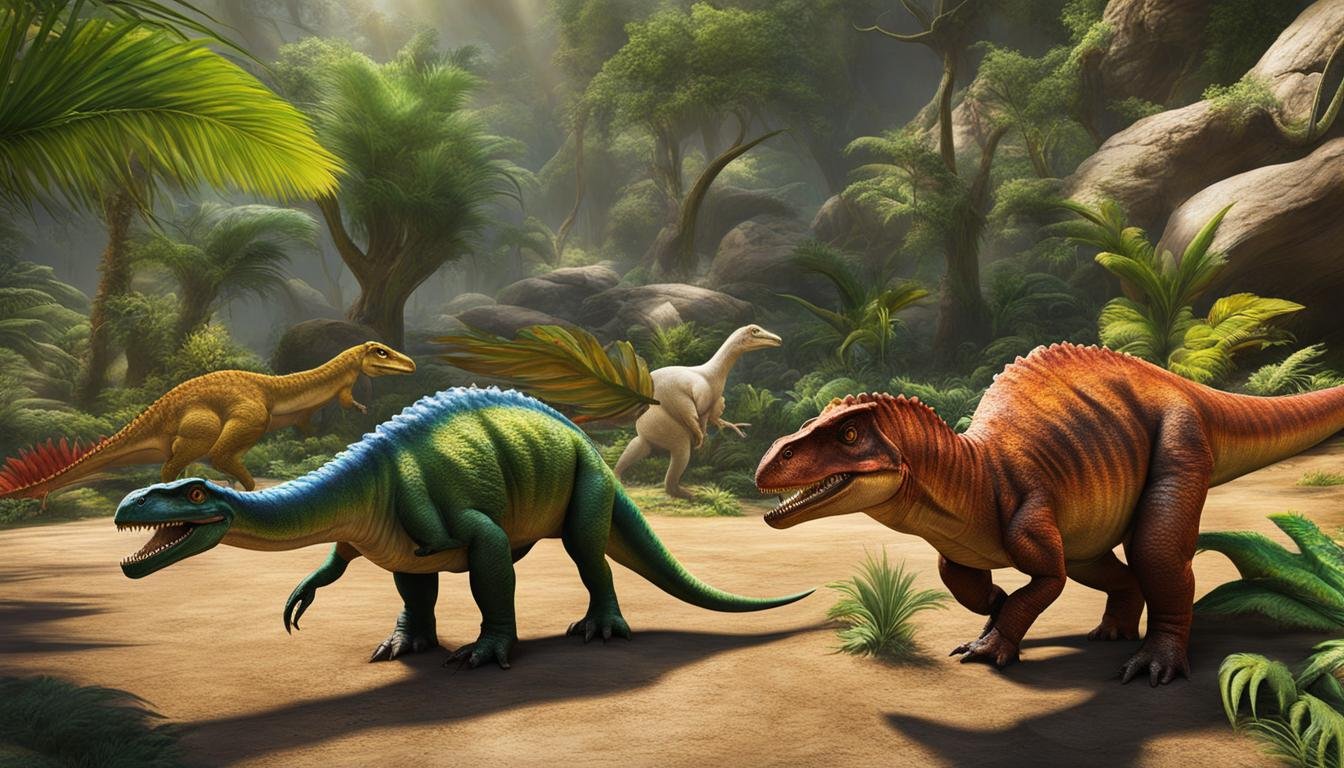Dinosaurs, like modern reptiles and birds, built nests to keep their eggs warm. The materials and techniques used in nest construction determined the warmth of the eggs, which, in turn, influenced the dinosaurs’ ability to live in different climates. Some dinosaurs preferred soil or plant materials to build mounds, while others dug holes in the sand. The temperature of the holes was slightly higher than the air temperature, relying mainly on heat from the sun. Mounds made of soil and plants, on the other hand, were significantly warmer than the surrounding air, thanks to heat generated by decaying organic matter. This allowed the dinosaurs to reproduce in colder climates. The study of living animals’ nesting strategies, such as crocodiles and birds, helps in understanding the nesting habits of extinct dinosaurs. The relationship between nest types, building materials, and heat sources observed in modern animals can provide insights into the nesting habits of non-birdlike dinosaurs. The nesting behavior of dinosaurs played a role in their distribution and habitat preferences.
| Main Point | Description |
|---|---|
| Nesting for Temperature Regulation | Dinosaurs constructed nests as a means to keep their eggs warm and to adapt to different climatic conditions. |
| Variety in Nest Construction | Some dinosaurs built mounds using soil or plant materials, while others created nests by digging holes in the sand. |
| Differences in Nest Temperatures | The temperature in sand holes was slightly higher than the ambient air, whereas mounds made of soil and plants were significantly warmer. |
| Learning from Modern Relatives | Studying the nesting strategies of crocodiles and birds provides insights into the nesting habits of extinct dinosaurs. |
| Impact on Distribution and Habitat | The nesting behavior of dinosaurs influenced their geographical distribution and preferences for certain habitats. |
Preferred Nesting Materials and Methods
Different dinosaurs had preferences for specific materials and methods in nesting. Some dinosaurs used soil or plant materials to build mounds, while others dug holes in the sand. The mounds constructed by certain dinosaurs were heated by microbes as they decayed organic matter, making them warmer than the surrounding air. This allowed dinosaurs to reproduce in colder climates, including Arctic regions. The holes preferred by some dinosaurs relied mostly on heat from the sun and had temperatures slightly higher than the air temperature. The choice of nesting materials and methods played a crucial role in determining the warmth of the eggs and the success of incubation in various climates.
Nest Types
There were several types of nests that dinosaurs used for egg incubation. The most common types included mound nests and hole nests. Mound nests were constructed using soil and plant materials, forming large mounds that provided extra warmth for the eggs. On the other hand, hole nests were created by digging holes in the sand or soil. These nests relied more on external heat sources like the sun to warm the eggs. The choice of nest type depended on the specific dinosaur species and their habitat preferences.
Nest Construction
The construction of dinosaur nests varied depending on the materials used. For mound nests, dinosaurs would gather soil and plant matter and arrange it in a mound shape, creating a warm and protected environment for the eggs. The heat generated from the decomposition of organic matter helped maintain the temperature inside the mound. In contrast, dinosaurs that preferred hole nests would use their claws or beaks to dig holes in the ground. These holes were typically shallow and provided a slightly warmer environment than the surrounding air.
| Nest Type | Construction Method | Heat Source | Climate Adaptation |
|---|---|---|---|
| Mound Nest | Constructed using soil and plant materials | Heat generated from decomposing organic matter | Adapted to colder climates |
| Hole Nest | Deep holes dug in the sand or soil | Relies on heat from the sun | Adapted to warmer climates |
The choice of nesting materials and methods played a crucial role in the survival and reproduction of dinosaurs. By understanding these preferences, we can gain insights into the ancient behaviors and adaptations of these fascinating creatures.
Nesting Strategies of Living Animals
To gain a deeper understanding of dinosaur nesting habits, researchers have turned to the nesting strategies of living animals such as crocodiles and birds. By studying these modern-day creatures, paleontologists can draw parallels and make inferences about the reproductive behaviors and parental care exhibited by dinosaurs. Crocodiles, for example, bury their eggs in nests on the ground and cover them with sand, dirt, and rotting vegetation to maintain the proper temperature for incubation. Birds, on the other hand, lay their eggs in open nests and incubate them by sitting on them.
This comparison between crocodiles and birds provides valuable insights into the potential nesting behaviors of dinosaurs. It suggests that certain types of nests used by living animals in cooler climates could have been utilized by dinosaurs as well. This includes open nests, which would have allowed dinosaurs to nest in locations other than on the ground. The study of nesting strategies in living animals helps bridge the gap between the behavior of modern creatures and their ancient counterparts, shedding light on the reproductive strategies employed by dinosaurs.
“By examining the nesting strategies of living animals, researchers can make inferences about the reproductive behaviors and parental care exhibited by dinosaurs.”
Understanding the nesting strategies of living animals also provides insights into the level of parental care exhibited by dinosaurs. For example, birds actively incubate their eggs by sitting on them, ensuring that the embryos receive the warmth they need to develop. This suggests that some dinosaurs may have also exhibited similar parental care behaviors, actively tending to their nests and providing warmth to their eggs. By studying living animals, scientists can gain a better understanding of the reproductive strategies and behaviors that existed in the ancient world.
| Dinosaur Nesting Strategies | Living Animal Analogies |
|---|---|
| Open Nests | Birds |
| Ground Nests | Crocodiles |
| Nest Incubation | Birds |
The table above summarizes some of the nesting strategies observed in dinosaurs and compares them to the nesting behaviors of living animals. This comparison provides a framework for understanding the nesting habits of dinosaurs and helps researchers piece together the puzzle of their reproductive strategies.
Evolution of Nesting Behavior
Understanding the evolution of nesting behavior among dinosaurs provides valuable insights into their reproductive strategies and the changes that occurred over time. The discovery of soft-shelled eggs in certain dinosaur species challenged the previous assumption that all dinosaurs laid hard-shelled eggs. This finding opened up new avenues of research and shed light on the diverse reproductive biology of these ancient creatures. Soft-shelled eggs were less likely to be preserved in the fossil record, leading to the misconception that hard-shelled eggs were ubiquitous among dinosaurs.
From an ancestral state of soft-shelled eggs buried underground, dinosaur nesting behavior evolved into the production of hard, sometimes colorful eggs incubated in partially open nests. This shift in nesting habits allowed for more varied distribution and nesting locations, contributing to the evolutionary success of certain dinosaur species. By examining fossilized nests and analyzing eggshells, researchers have gained insights into the intricate nesting behaviors of dinosaurs and how they evolved across different species.
The discovery of intact dinosaur nests and the analysis of fossilized eggs and eggshells shed light on the intricate nesting behaviors of dinosaurs and how they differed across species.
Comparisons with the nesting strategies of living animals such as crocodiles and birds have further enhanced our understanding of dinosaur nesting habits. The similarities and differences in nesting strategies between modern animals and dinosaurs provide valuable insights into the reproductive behaviors and care exhibited by these ancient creatures. These findings emphasize the unique characteristics of dinosaurs, showcasing a mix of bird-like and reptilian traits in their reproductive biology and behaviors.
| Dinosaur Species | Nest Type | Incubation Style |
|---|---|---|
| Tyrannosaurus rex | Open nest | Incubated by parents |
| Triceratops | Mound nest | Incubated by decaying organic matter |
| Velociraptor | Open nest | Incubated by parents |
The evolution of nesting behavior among dinosaurs showcases the complex nature of their reproductive strategies. Further research in this field continues to uncover new details about the fascinating world of these prehistoric creatures.
Dinosaur Nest Types and Brooding Sites
When it comes to dinosaur nesting behavior, fossil evidence reveals fascinating variations in nest types and brooding sites across different species. Most dinosaurs, similar to modern-day crocodiles, buried their eggs in nests covered with dirt and vegetation. However, small theropods closely related to birds took a different approach, laying their eggs in open nests, much like many bird species today. This unique nesting strategy may have allowed these theropods to establish nests in diverse locations, contributing to their evolutionary success.
Examining intact dinosaur nests and analyzing fossilized eggs and eggshells has provided valuable insights into the intricate nesting behaviors of dinosaurs. These findings highlight the diversity and complexity of their nesting habits. By comparing dinosaur nests to those of living animals, researchers can better understand the reproductive strategies exhibited by these ancient creatures.
“The variation in nest types among dinosaurs reflects the mix of bird-like and reptilian traits seen in these prehistoric creatures.”
| Dinosaur Species | Nest Type | Brooding Behavior |
|---|---|---|
| Tyrannosaurus rex | Buried nest | Incubation |
| Velociraptor | Open nest | Incubation and brooding |
| Triceratops | Mound nest | Incubation and brooding |
The table above showcases the nest types and brooding behaviors of three different dinosaur species. Tyrannosaurus rex preferred buried nests, while Velociraptor and Triceratops utilized open nests. These variations in nest types and brooding behaviors demonstrate the diversity and adaptation of dinosaurs in their reproductive strategies.

Overall, the study of dinosaur nest construction and brooding sites provides a deeper understanding of the reproductive biology and behaviors of these ancient creatures. The comparisons with modern animal nesting strategies, accompanied by fossil evidence, shed light on the complex nature of dinosaur nesting habits and the unique characteristics they exhibited. Further research continues to uncover new details about the intriguing world of these prehistoric giants.
Conclusion
The study of dinosaur nesting and brooding behaviors provides valuable insights into the lives of these fascinating ancient creatures. By examining the materials and techniques used in nest construction, researchers have been able to understand the warmth of dinosaur eggs and its impact on their distribution and habitat preferences.
Comparisons with the nesting strategies of living animals such as crocodiles and birds have played a significant role in understanding the reproductive strategies exhibited by dinosaurs. These comparisons have revealed similarities and differences, shedding light on the unique characteristics of dinosaur reproductive strategies.
The evolution of nest types and brooding behaviors over time further highlights the complexity and diversity of dinosaur nesting habits. As researchers continue to uncover new details, the research on dinosaur nesting and brooding behaviors continues to unveil the fascinating world of these prehistoric creatures.









